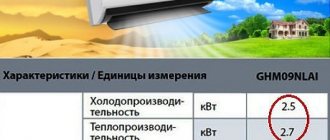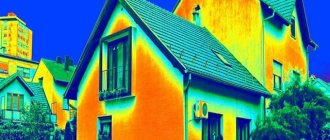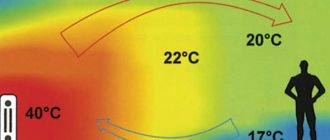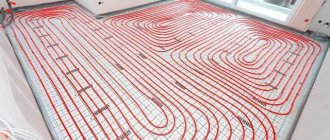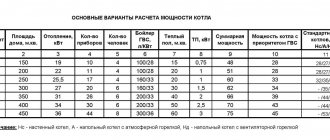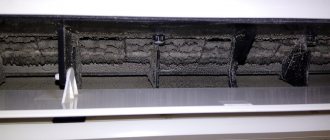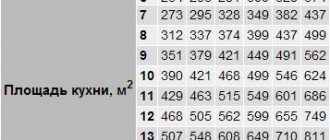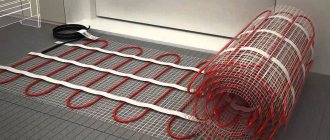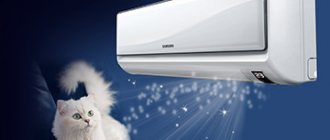Few owners of split systems know about all the existing characteristics of this climate control device. In addition, not everyone understands what characteristics of air conditioners should be paid attention to first. This article will be instructive for those who wish to independently study the parameters of the device for its further error-free operation.
Technical characteristics will be considered for the most common types of devices, such as wall-mounted air conditioners. It should be noted that all the main parameters listed apply to other types of air conditioners, both industrial and domestic. Installations of this type have one common and main indicator - productivity.
Air conditioner power
When considering such an important parameter as power, you need to keep in mind that this value for climate control devices has two different concepts. The cooling power is not at all equal to the consumption power. To create coolness in a room, you need three times less energy consumed than the device actually spends.
Let’s say a split system with a capacity of 2.4 kW has an electricity consumption power of about 800 W, which is comparable to the operation of an electric iron. Typically, both characteristics are indicated on the tag and in the accompanying instructions for the device.
Cooling power
Perhaps the most basic technological parameter for an air conditioner is cooling power. Its cooling capacity will depend on this indicator, that is, how much area in the apartment it can process as usual.
For example, if the room is 28 m2 in size, and the device is designed for 22 m2, then it will constantly operate at the highest load, which will lead to a decrease in its service life. The cooling power is indicated in kW. It is generally accepted that 1 kW of the cooling capacity of a split system can cool 10 m2 of room area with a ceiling height of 2.8 m.
Heating power
The next technological parameter is the heating power. As a rule, this value is slightly higher than the previous value. Heating performance is also calculated in kW and indicates the amount of energy provided by the air conditioner, but only in the “heating” mode.
Power consumption
Power consumption of electricity - this parameter of the air conditioner is also expressed in kilowatts (kW), but it has different types of loads:
- greatest;
- average;
- smallest.
Thus, this characteristic serves to indicate the specific load and the required amount of electricity consumed by the split system.
How to calculate the power consumption of an air conditioner for a room
You can calculate the power of the air conditioner both for a room and for any household premises yourself.
Let's take a room: area 20 sq. m, ceiling height 3 m, accommodates 1 person, has a computer, TV and refrigerator. The room is sunny, office equipment works alternately.
Calculation:
- Heat inflows into the room are the sum of the walls and ceiling Q1, from the person Q2 and from the equipment that produces heat Q3.
- In the solar room, to determine Q1, q 20x3x40/1000 = 2.4 kW is used. Q2 is assumed to be 0.1 kW in a quiet state. Q3 is determined by the sum of the heat emission of a computer, as the most expensive - 0.3 kW and a refrigerator 30% of the power of 150 W - 0.05 kW. Heat dissipation – 2.4 kW + 0.1 kW + 0.35 kW = 2.85 kW.
- Using Q range (-5~+15)% you need to look for an air conditioner with a cooling capacity of 2.7 - 3.3 kW.
- We select a model of suitable power from the table.
When independently choosing a climate system based on cooling power, you must take into account that the power of the air conditioner may not be in kilowatts, but in units of BTU/hour, this indicator corresponds to the British inch/pound measurement system. You can use a plate that connects the model range with the power of the air conditioner, according to the British and international systems.
| Row | BTU | kW | Row | BTU | kW |
| 7 | 7000 | 2,1 | 36 | 36000 | 10,6 |
| 9 | 9000 | 2,6 | 42 | 42000 | 12,3 |
| 12 | 12000 | 3,5 | 48 | 48000 | 14,0 |
| 18 | 18000 | 5,3 | 54 | 54000 | 15,8 |
| 24 | 24000 | 7,0 | 56 | 56000 | 16,4 |
| 28 | 28000 | 8,2 | 60 | 60000 | 17,6 |
Knowing the cooling capacity, you can always determine how much power the air conditioner consumes in units of measurement.
It is important to choose the right split system, window or floor air conditioner. Excessive power consumption can lead to disruption. Thus, calculations for a small room allow you to select a mobile unit, wall and window air conditioners. Floor-ceiling and duct fggfhfns are used if the area is more than 26 square meters. meters.
EER and COP coefficients of air conditioner efficiency
Energy efficiency is an indicator that depends on the above parameters and indicates the efficiency of air conditioner modes from an energy standpoint. In this case, the efficiency is equal to the coefficient, which is calculated by the ratio of the produced power (cooling or heating) to the consumed performance.
For example, a split system with a cooling capacity of 2.4 kW consumes 0.8 kW of electricity to create coolness. The energy consumption efficiency factor will be 3.0. Today, in modern standards, energy efficiency is divided into classes, with each class corresponding to the required value of such an indicator. In our case, efficiency “three” means European class “A”.
Video description
This video shows how to measure the current consumption and power of an air conditioner:
Lack of power
A weak split system will not be able to fully perform its job or will work at its maximum capacity. As a result, it will break faster, or you will have to keep it on all the time, which again leads to breakdowns. If the air conditioner fails to cope even with constant operation, the room will be hot, and only under the device itself a strong air flow will blow.
If there is not enough power, the air conditioner cannot cope Source i.ytimg.com
Seasonal SCEER and SCOP coefficients
SEER and SCOP are higher than standard EER and COP. The reason is that seasonal efficiencies are used in America, where productivity is determined not in kW, but in BTU/hour, and the energy consumed is measured in standard kilowatts. At the same time, 1 W is approximately equal to 3.41 BTU/hour. This means that the indicators of such coefficients are 3.4 times higher than the data obtained when calculating only in watts.
The main reason for introducing such seasonal coefficients is the need to determine the results of the functioning of the split system actually, that is, throughout the year. In European standards, the SEER indicator is calculated as the ratio of the amount of refrigeration capacity generated over four seasons to the electricity consumed during the same period.
What is an inverter air conditioner?
Climate control units with an inverter are split systems that have smoothly varying power during operation. In this case, the inverter allows you to convert direct current into alternating current of a given frequency, that is, change the engine speed and compressor power.
During operation, the unit does not turn off completely, like standard air conditioners, but only reduces the power and speed of refrigerant movement. Thanks to this smooth change in parameters, the air flow in the “cool” mode is only slightly warmer than the room temperature.
It is precisely this feature of products with an inverter that suggests that they are more comfortable to operate and more accurate when maintaining a certain temperature. In addition, such split systems allow up to 30-35% energy savings and produce less noise compared to standard air conditioners.
Typically, the instructions for inverter devices indicate not just one performance indicator, but an interval in which power changes can occur. The larger this range, the more accurately temperature and other indicators can be maintained.
How much electricity does an air conditioner consume?
The energy cost coefficient for energy efficiency indicators denotes the volume of electricity consumption, which represents the dependence of the refrigerant production productivity of the equipment on the volume of electricity. Also, the coefficient shows the dependence of the performance aimed at dissipating heat by the device on the amount of electricity consumed.
Air conditioner energy efficiency
The highest consumption of energy source in equipment operation is achieved due to the use of warm outside air to increase the temperature in the room and to exhaust air through cooling tubes.
Electricity consumption is expressed in kW. On average, the power consumption of an air conditioner is less than the operating power for cooling or heating the air. For example, equipment that uses 600 W of power spends 2 kW to cool the room through the use of freon or another refrigerant carrier.
Basically, the electricity consumption of equipment depends on the following factors:
- Total area of the working space;
- Device performance;
- Temperature difference between indoors and outdoors.
The power spent on working with the temperature in the house is one of the main indicators of air conditioner performance and is determined by heat inflows from windows, ceilings, walls or household appliances. Do not forget that high performance of the air conditioner is achieved only with closed openings (windows or doors). The air flow from the window opening is not properly regulated, so it is difficult to correctly calculate the power of the air conditioner. If the door or window is open, the equipment does not guarantee effective cooling or heating of the air. This means that electricity consumption will increase by 15%.
Manufacturers recommend adhering to normal load conditions for a device operating in hot weather. After obtaining the value of daily electricity consumption, the indicator is multiplied by the number of days in a certain period. This allows you to roughly calculate your electricity consumption for a month or a year.
The average is determined by the given temperature range in the room and weather conditions.
Split system noise level
When choosing climate control units, it is necessary to take into account the noise level during the operation of the indoor unit, and sometimes the outdoor unit. This characteristic of the air conditioner is especially important when installing it in a child’s room or bedroom.
To give an idea of what the noise produced by the device is, below are the sounds produced by different phenomena for comparison. It should be noted that noise is measured in decibels (dB) and is a relative value that reflects the difference in sounds.
So, the noise level in decibels is approximately equal to the following reproduction of external sound effects:
- 0 dB – hearing threshold;
- 24-28 dB – whisper;
- 28-45 dB – noise level during normal conversation;
- 46-70 dB – noise level of a busy city street.
In the indoor air conditioner unit, the noise comes mainly from the ventilation device and the air flow. Most indoor units produce a noise effect of 22–30 dB, while outdoor units produce a noise effect in the range of 32–55 dB.
How much does an air conditioner consume in monetary terms?
Approximate calculation of consumption per season:
If you use a 0.7 kW air conditioner (“seven”) 10 hours a day, for 3 months in a row, then it will consume approximately 300 kW (taking into account the fact that during these 10 hours, if chosen correctly, the compressor of the device works only half the time). With the cost of electricity being 3.5 rubles/kWh, the cost of electricity is 1050 rubles. Inverter air conditioners can save up to 30% of this amount.
For comparison:
- TV approximately consumes 0.3-0.5 kW/hour of electricity;
- iron 2.0-2.5 kW/hour;
- computer 0.4-0.5 kW/hour;
- air conditioner “nine” 0.6-0.9 kW/hour.
Thus, we found out how much the air conditioner consumes per season and what these indicators depend on. Read the article “how to choose the power of a split system.”
Possibility of taking in new air
Only duct air conditioners can take in new air. Standard wall-mounted or other types of appliances only create coolness or heat due to air exchange inside the room. There are also air conditioners with a “ventilation” mode, which means the additional operation of the indoor unit’s fan without the participation of a compressor.
However, if the windows in the apartment are made of double-glazed windows, then to ensure a comfortable microclimate, forced forced ventilation may be enough, which will be cheaper than installing an air conditioner.
The main consumption functions of an air conditioner
Today, every split system has a touch screen to control different modes. Using it, you can set a certain temperature, humidity, timer, etc. Moreover, in terms of the number of modes, economy class devices differ little from premium class models.
The bottom line is that, basically, the manufacturer does not need to change the design of the air conditioner, but only needs to configure the microcontroller and insert an additional key on the remote control.
There are the following main modes:
- Cool and warm. These functions are decisive among others and are used for cooling and heating the room.
- Ventilation. Used without a compressor. In summer - for the influx of fresh air, and in winter - for redistribution of the upper and lower layers of air.
- Auto mode. In this process, the equipment itself selects the functions of heating, cooling and humidity to create a comfortable microclimate.
- Drying. In this mode, the device reduces the humidity in the room, and this function is similar to the cooling process, only without a noticeable drop in temperature.
- Air cleaning. To implement this mode, coarse and fine filters are installed behind the front panel.
- Fan speed. As a rule, in the indoor unit the fan has the ability to regulate the rotation speed of the impeller.
- Air flow direction. This function is carried out through vertical and horizontal blinds, which change their position using the control panel.
- Timer. Using this daily device, you can set the device to turn on automatically, for example, an hour and a half before returning home from work.
- Night mode. After setting this function, the compressor will operate at minimum power and the fan at the lowest speed, creating a favorable microclimate for falling asleep.
Modern air conditioners also have other important functions, such as ionization, which, in addition to purification, saturates the air with silver ions.
Additional parameters to consider when choosing an air conditioner
There are many factors that have a significant impact when choosing an air conditioner.
First of all, it is necessary to take into account the role of fresh air flow when opening a window. The simplified method for calculating air conditioner power does not take into account opening windows for ventilation. This is due to the fact that even the operating instructions for the system indicate that the air conditioner should only operate with the windows closed. In turn, this creates certain inconveniences, since windows can only be ventilated when the device is turned off. Solving this problem is not difficult. You can ventilate the room with the air conditioner on at any time, but you should not forget to close the entrance door to the room (so as not to create drafts). It is also necessary to take this nuance into account when calculating the power of the system. For this purpose Q1
increase by 20% to compensate for the heat load from the supply air. It is necessary to understand that with an increase in power, electricity costs will also increase. For this reason, air conditioners are not recommended for use when ventilating rooms. At the highest possible temperature (summer heat), the air conditioner may not maintain the set temperature, since the heat influx may be too strong.
If the cooled room is located on the top floor, where there is no attic, then heat from the heated roof will be transferred into the room. Heat inflows from the ceiling will be much higher than from the walls, so we increase the power of Q1
by 15%.
The large glass area of the windows also plays a significant role. It's pretty easy to follow. It is enough to measure the temperature in the sunny room and compare it with the others. During the usual calculation, the presence of a window in a room with an area of up to 2 m2 is provided. If the glazing area exceeds the permissible value. Then for every square meter of glazing an average of 100-200 W is added.
An inverter air conditioner is well suited to operate over a wide range of heat loads. It has variable cooling power, so it is able to create comfortable conditions in a given room.
Air conditioner protection systems
While the modes of most split systems are identical, the functions of protection against the influence of external factors, on the contrary, differ in many respects from each other. At the same time, 100% control over the control of the air conditioner involves the installation of a large number of sensors, circuit breakers and other devices.
And this, in turn, increases the cost of equipment by 20-28%. Due to the rising cost of devices, manufacturers do not always build in protection against illiterate use, especially for economy class devices. Therefore, when choosing a split system, buyers need to pay special attention to this.
Basic protection and control systems:
- Monitoring the condition of filter elements. If there is a blockage, the indicator light on the display lights up. This is a very necessary warning, because when working with dirty filters, pathogenic bacteria can penetrate through them, which affects human health. Their contamination also affects the purity of the incoming air and refrigerant.
- Restart. This function allows the device to start after a sudden power outage.
- Control of refrigerant leaks. In today's air conditioners, instead of low-pressure relays, manufacturers increasingly began to use an integral protection system. Pressure is measured at key points in the line, and this information is integrated, then based on it, the freon pressure in the circuit is analyzed.
- Current protection. Using this characteristic, an experienced specialist can determine a list of problems in the split system. For example, a reduced current indicates idling of the compressor, that is, insufficient gas pressure in the line. Increased current may indicate heating of the compressor motors or fans.
- Automatic defrost. Due to low gas pressure in the circuit, the evaporator may freeze, which disrupts the entire operation of the refrigeration system of the device. Therefore, when such a control light comes on, you must first of all pay attention to the compliance of the pressure in the system.
- Protection in winter at sub-zero temperatures. Each split system has its own temperature range, set by the manufacturer, at which uninterrupted operation of the equipment is possible. Usually it is allowed to operate the device at a temperature not lower than – 5 degrees. Some models have a temperature sensor installed, which gives the command to turn off the device if this indicator is exceeded.
There are also RCD devices and circuit breakers that protect people from electric current.
How to calculate power depending on the area of the room
The easiest way to select an air conditioner based on the area of the room is to pay attention to the parameters specified by the manufacturer. Typically this information is in the form of numbers - 7, 9 or 12 kBTU. This number is necessarily contained in the model name. It’s quite easy to navigate them:
- 07 – for a small room, no more than 20 sq.m;
- 09 – for rooms from 20 to 26 sq.m;
- 12 – for rooms up to 35 sq.m.
More power is usually not required for domestic premises. To choose the right device, you need to know the area of the room (you don’t have to remember it by heart, just read it in the technical data sheet at home) and compare it with the number indicated on the packaging.
Some companies use not only the listed numbers, but also intermediate values - 05, 10, 13, etc. This creates a wide variety of air conditioners and the ability to choose a device specifically for your needs, but it complicates the calculations. For this case, the general formula is suitable:
1 unit = 3 sq.m
The larger the area, the more powerful the air conditioner is needed Source zelclimat.ru
This is a simplified calculation, but it will help you avoid confusion when choosing a technique.
Some manufacturers (for example, Mitsubishi) indicate on the packaging the recommended room area in square meters, and calculating the air conditioner by room area is no longer necessary.
To convert from one unit to another, the formula is used:
1 kBTU = 293W
It refers to the cooling intensity, not the electricity consumed.
How does ceiling height affect
The previous section discussed only the area of the room, but residential buildings can have completely different ceiling heights. This affects the volume of air that the air conditioner will work with. Required power:
- With ceiling heights from 2.5 to 3 m – 100 W/sq.m;
- 3-3.5m – 120W/sq.m required;
- At 3.5-4m – 140W/sq.m.
Further, this rule remains the same - every 0.5 m of ceiling height requires an additional 20 W of air conditioner cooling power per square meter. If the power of the device is indicated in units, then it must first be converted to W. Manufacturers' recommendations usually apply to rooms with a ceiling height of 2.5-3 m.
A high ceiling requires a more powerful air conditioner Source 2.bp.blogspot.com
Heat sources
The air conditioner parameters are indicated for a room in which the air will not be heated additionally. Additional sources of heat in an enclosed space are people, animals and household appliances in it.
In fact, each of these objects emits a different amount of heat - a person can actively move or sleep, the most active air heater is a constantly turned on TV. But for simplicity, the calculations use the same value - 300W for each person, animal and household appliance.
Children are taken into account on the same basis as adults - they move a lot and exchange heat more intensely with the environment. If the number of people in the room is constantly changing, the maximum parameter is taken into account.
Of the animals, only warm-blooded ones are taken into account; for cats, small dogs and rodents, you can “make a discount” and count 100 W per animal. Pets in terrariums and aquariums do not have a significant impact on the temperature of the house, but you need to take into account the equipment that provides them with air and the optimal temperature. Plants are not taken into account when calculating the air conditioner.
People are also sources of heat Source mtdata.ru
See also: Catalog of companies that specialize in ventilation, air conditioning and lighting
Calculation examples
When calculating the power of the air conditioner based on the area of the room, you need to remember that all results will be approximate. There are many factors that are usually not taken into account - the thickness of the walls and finishing features, open windows or doors, the sudden arrival of guests who are a source of heat, etc.
Example No. 1
As an example, let’s take a room with an area of 24 sq.m. with a ceiling height of 2.5 m, in which 2 people and a cat live, 2 laptops are turned on during the daytime. The calculations look like this:
- With such a ceiling height, 100W of cooling energy per sq.m. is required, i.e. 2,400W for the entire room;
- People, equipment and cats each require another 300W of additional power, i.e. another 1,500W;
- The required power is 3,900 W, i.e. approximately 13kBTU.
At night, when the equipment is turned off and people are sleeping, the power of the device may be excessive (the dangers of this will be discussed below).
Example No. 2
Another example of calculating an air conditioner by area is for a small room with an area of 12 square meters, but with a ceiling height of 3.5 m. A man and a dog live in a room; guests come every weekend - 3-5 people.
Man and dog – the warmth of friendship is quite palpable Source www.rmim.com.tw
The calculations look like this:
- 140W is required per 1 sq.m (based on the height of the ceilings), i.e. 1 680W;
- A person and a dog each require 300W, i.e. 600W extra;
- Guests also require 300W, i.e. 900-1,500W when they arrive;
- The total power is 2,280W (about 8 units) for the owner or 3,180-3,780W (about 10-12 units) including guests.
Whether it is necessary to take into account people who are not in the premises all the time, but come quite regularly, is decided only by the owner of the premises. Manufacturers advise buying equipment with a reserve, since it is easier to cope with excess power than with its lack.
The location of the air conditioner also affects efficiency Source streetclimate.ru
Freon type
Freon is a mixture of ethane and methane, which is converted into a compound of fluorine and chlorine. It is used as a refrigerant for refrigeration units, including air conditioners. Such freon is a coolant, the composition and properties of which largely determine the efficiency of the split system.
When moving in a closed loop, it is successively converted into a liquid and gaseous state, while either giving off heat or absorbing it. There are several types of freon, differing in the content of fluorine and/or chlorine. In climate control devices, R-12, R-22, R-134a, R-407C, R-410A, etc. are most often used.
Since 2003, manufacturers have stopped using R-12 and R-22 freon due to its toxicity, and have switched to European standards. In connection with the transition to a new coolant, not only equipment, but also installation work, as well as service, have become more expensive. What is the difference between these seemingly similar refrigerants?
The difference between them is in the properties of the gas and it stands out as follows:
- Freon R-407C and R-410A have increased pressure to transform into a liquid state (25 atmospheres versus 15 units for freon R-22). Consequently, the main line and all its components are made more durable (with thicker walls near the tubes), and therefore more expensive.
- Freon, safe for the ozone layer, has different compositions; it is a mixture of simpler freons, that is, with the lowest content of chlorine and fluorine. For example, R-407C contains three compounds: R-32, R-134a and R-125. This is negatively reflected in the fact that when a gas leaks, light components evaporate first, and the entire composition of the injected gas changes. Therefore, in the case of a missing refrigerant, the coolant has to be completely changed, unlike freon R-12 and R-22, where it was possible to simply refill the system.
- The oil in the R-407C and R-410A refrigerant circuit must be polyester. Unlike the mineral lubricant that was used in previous freons, it has increased hygroscopicity. This means that polyester quickly absorbs liquid from the air, which negatively affects the operation of the entire system
And the most important difference is the high cost of new freon, its price is $32-35 per 1 kg, which is 7-8 times more than the cost of R-22 freon.
Main characteristics of air conditioners
15.11.2018
In this article we will tell you about the main technical characteristics of air conditioners, which have a significant impact on the quality of the air conditioner and comfort in the refrigerated room.
Air conditioner power
One of the most important characteristics of an air conditioner is its cooling capacity. When calculating the required air conditioner power, we assume 1 kW of power for every 10 square meters of room served. In addition, to calculate the required cooling capacity, it is also worth considering the presence, size and orientation of windows in the building. You also need to take into account the fact that the equipment in the room served by the air conditioner generates heat: this factor must be taken into account when calculating such an important characteristic of air conditioners as cooling power. You can make the calculation in our air conditioner power calculator.
Possibility of air heating
The ability to heat air is an important characteristic of an air conditioner; equipment with this ability can serve as a heater in the off-season. At the moment, almost all air conditioner models on the market have the ability to heat the air. It is important to know that using an air conditioner for heating is possible only at an outside temperature of at least -10 ... -5 degrees. WITH.
Air conditioner power consumption
The power consumption of an air conditioner is a rather critical characteristic, since the electrical wiring of old houses often cannot withstand a significant load, and energy savings are becoming more and more justified. The power consumed by an air conditioner differs from the cooling power by approximately three times. In other words, with a cooling power of 3 kW, the power consumption of the unit itself will be 1 kW. From the ratio of the cooling power to the power consumed, another important characteristic appears - the energy efficiency coefficient. According to international standards, the energy efficiency coefficient of an air conditioner for cooling is designated EER, and for heating – COP. Based on the values of these coefficients, the energy efficiency class of the air conditioner is determined. Below are the values of the coefficients and the corresponding energy efficiency class.
Inverter air conditioner
Inverter air conditioners differ from non-inverter air conditioners in their ability to regulate power depending on the room temperature. If the temperature reaches the set value, the compressor begins to operate in economical mode, reducing energy consumption by 40% and reducing noise levels by up to 35%. Learn more about inverter air conditioners.
Noise level
Noise level is an important characteristic of an air conditioner, especially if the air conditioner is planned to be installed in a quiet room, such as a bedroom. Typically, the noise level of air conditioners varies between 22-36 dB (for an indoor unit) and 38-54 dB (for an outdoor unit). For example, a noise level of 30 dB can be compared to the whisper of a person or the ticking of a wall clock, 20 dB is comparable to the quiet rustling of leaves. Most air conditioner manufacturers try to achieve a low noise level of the indoor unit of the air conditioner. But you need to understand that the laws of physics are rarely deceived, so you should not blindly trust all the stated figures, because measurements could be carried out under ideal conditions. It should also be understood that in order to create a powerful air flow, the air conditioner increases the speed of the drum fan of the indoor unit; as a result, in terms of noise level, air conditioner models with larger dimensions of the indoor unit (width) remain leaders, because they will require a lower speed to create a powerful air flow fan If you are choosing a quiet air conditioner, you should pay attention to models from such manufacturers as Daikin, Panasonic, Mitsubishi; these air conditioners have long conquered the market of “quiet models” and are rightfully considered leaders in this direction.
Filters
In most cases, air conditioners are equipped with a filter to clean the air. Large dust particles are removed by coarse filters. Fine filters are designed to remove small dust particles. The air conditioner can also be equipped with an ionizer or other devices that improve indoor air quality.
Operating modes
The main operating modes are cooling, heating and ventilation (air circulation without cooling/heating)
Automatic mode - in this mode, the air conditioner itself selects the operating mode to maintain a comfortable microclimate in the room.
Dehumidification - in dehumidification mode, air humidity decreases; in this case, the room temperature decreases by no more than 1°C.
Night mode - In this mode, the air conditioner reduces the fan speed and increases or decreases the room temperature for several hours.
We wish you a pleasant climate!
Distance between air conditioner units
The length of the line between the modules plays a big role, both for installation and for the service life of the climate control device as a whole. According to the standard scheme, the size is determined by the length of the component copper tubes, which is 6 meters. It is not recommended to increase this length unless absolutely necessary for two reasons:
Firstly, the cost of installation increases due to additional copper pipes, increased freon consumption during refueling, and also the gating of walls.
Secondly, with a longer line length, the load on the compressor increases, and its service life decreases accordingly.
As paradoxical as it sounds, a circuit that is too short also negatively affects the operation of the split system. The fact is that after the compressor and the throttling device, the freon on its way to the evaporator of the indoor unit must be completely converted into a liquid state.
In the case of a short distance, this may not happen and then a failure will occur during condensation in the expansion tank, which will affect the temperature during cooling. To prevent this from happening, in this case the excess tubes are usually rolled up into a coil.
If the distance between the modules is more than 16-20 meters, then it is recommended to use a semi-industrial air conditioner rather than a household one.
How to reduce the electricity consumption of an air conditioner
Here are some simple ways to reduce costs:
- Choose an inverter model that consumes less electricity.
- If possible, cover windows with blinds or curtains to reduce heat gain from the sun in the room.
- Do not open windows to prevent hot air from entering.
- Optimal parameters are 22-23 C°. Reducing the temperature by a degree increases electricity consumption by 5-8%.
- Clean the filters and heat exchanger regularly. A dirty device takes a long time to reach the desired temperature.
- Do not open the doors to the refrigerated room to prevent the cold from escaping from the room.
As you can see, installing an air conditioner does not involve huge expenses. An extra thousand a month is a small price to pay for the comfort of your own home.
The influence of climate on the operation of an air conditioner
For the smooth functioning of the split system, the air temperature outside the window plays a significant role. At the same time, each product has its own temperature range. On average, for standard models, operation of climate control devices in the “cooling” mode is allowed from – 5 to + 42 degrees.
If operation occurs in violation of these limits, especially the lower limit, then this will certainly lead to malfunctions in the functioning of the system. It is even possible that the radiator may get frostbite, a change in the quality of freon, problems with the compressor, or even complete failure.
Power calculation for a household air conditioner
types of air conditioners
Why is it so important to correctly calculate and select an air conditioner based on power (cooling capacity)?
Insufficient optimal power entails the operation of the device in non-stop mode - it will try to reach the required temperature in the room. If there is an excess of optimal power, the air conditioner will operate in constant start/stop mode and produce too strong flows of cooled air, which cannot be distributed normally around the entire perimeter. Both options instantly wear out the compressor.
Ideally, climate control equipment should operate in such a way that there is no unnecessary heat load, since any air conditioner can only compensate for a limited amount of heat.
Having correctly calculated the power of the air conditioner, after reaching the set temperature, the compressor turns off, and then only the room module functions. As soon as the parameters have increased by a couple of degrees, a command about this is sent to the compressor through temperature sensors, and it turns on again.
When purchasing a household split system or monoblock, you can make a simplified power calculation, taking into account only the area of the room.
It is generally accepted that on average 1 kW = 10 m². Therefore, a room with an area of 17 m² requires a cooling capacity of 1.7 kW. Air conditioners are produced with a power of 1.5 kW, but not all manufacturers have such low-power models. And the next value is usually 2 kW. If the side is sunny, the room is equipped with a large number of equipment, and several people are regularly there, then it is better to give preference to larger values - 2 kW or 7 BTU.
Low power air conditioners correspond to the following table of values:
| Area, m² | power, kWt | Power, BTU/h |
| 15 | 1,5 | 5 |
| 20 | 2 | 7 |
| 25 | 2,5 | 9 |
| 35 | 3,5 | 12 |
| 45 | 4,5 | 14-15 |
| 50 | 5,0 | 18 |
| 60 | 6,0 | 21 |
| 70 | 7,0 | 24 |
A typical calculation of power by room area is done according to the generally accepted scheme:
Q1 = S * h * q / 1000
where Q is the power during cold operation (kW), S is the area (m²), h is the ceiling height (m), q is a coefficient equal to 30 - 40 W/m³:
q = 30 for shadow side;
q = 35 for normal light penetration;
q = 40 for the sunny side.
Q2 is the total amount of heat excess from people.
Excess heat from an adult:
0.1 kW - with minimal activity;
0.13 kW - with low or medium activity;
0.2 kW - with increased activity;
Q3 is the total amount of heat inflow from household appliances.
Excess heat from household appliances:
0.3 kW - from PC;
0.2 kW - from TV;
For other devices the value is based on 30% of the maximum power consumption.
The climate control power should be in the Qrange from -5% to +15% of the design power Q.
Please note that this is an approximate estimate and may have errors. Even when selecting a low-power air conditioner for an apartment or office, it is advisable to use the services of professionals and calculate everything for sure, since the simplified method for calculating power provides for a minimum amount of equipment, ceiling height and number of people.
Why do you need an online calculator?
Today, many online storefronts offer a service such as a calculator for calculating the power of an air conditioner, which can easily be used to determine the exact value of the cooling capacity, taking into account all the features of the room. This is very convenient - even a simple layman can use it without special knowledge in the field of air conditioning systems. Why might such a skill be needed? So that an unscrupulous seller does not try to mislead a person by trying to sell him a device of inappropriate power that is lying in a warehouse.
At the end of the article, you can watch a video with detailed instructions on how to use the air conditioner power calculator for an ordinary buyer.
It is worth remembering that these types of standard calculations are only suitable for domestic and administrative premises with an area of no more than 70-80 m², without additional technical equipment and large crowding of people on the territory. The types/types of compressor are also important. This is also taken into account when selecting an air conditioning system for an apartment or office.
Thus, with the calculation of air conditioner power by room area, everything is clear - its results are quite conditional, and they are unsuitable for multi-systems or centralized air conditioning systems in industrial buildings.
Additional devices
For normal operation of the air conditioner, its design includes various devices to protect a particular mechanism or technological process.
Year-round block
When purchasing a new air conditioner, you should consider models with adapted designs for winter conditions. Now some modern devices with an inverter are capable of operating down to -25 degrees at a temperature outside the window, but the price increases by 8-10 thousand rubles.
And also for all-season use of the split system, it is recommended to use a winter heating kit on standard appliances. It heats the drainage system and the crankcase of the compressor. It should be borne in mind that you can use the air conditioner in winter only during the “cooling” process.
Thus, the use of a winter kit is justified in two cases:
- To increase the reliability of the air conditioner. This adaptation makes it possible to use the climate control unit at any time of the year without worrying about condensation leaks and compressor jamming.
- A winter-adapted device is necessary in rooms with high-precision equipment, for example, in server centers and some laboratories during technological operations.
Drainage pump
When installing climate control equipment, it is sometimes necessary to install a drainage pipeline with a difference in height (for example, in a basement). In this case, a pump is required to raise the liquid to the desired height. This device looks like a rectangular plastic case, which houses a small pump and a container with a sensor for turning the pump on and off. After water has accumulated in the tank, the pump turns on, the liquid is pumped out, and then the pump stops and the cycle repeats.
Protective visor
When installing an external unit, a metal canopy is usually installed above it to protect against possible falling icicles and snow from the roof of the house. In this case, the distance between the module housing and the safety visor must be at least 12-15 cm. This means that the outdoor unit must be mounted under the window taking into account this protection, and the distance from the upper edge of the housing to the window sill must be maintained at 20-25 cm.
Protective box (grid)
Sometimes the external unit has to be installed in an easily accessible place: at a low altitude, on the roof of a house, etc. In such cases, grilles are often installed to prevent vandalism, which at the same time can be easily removed for maintenance. As a rule, the protection is made in the form of a rectangular box made of metal on three sides, and a large mesh on the side or bottom for inspection.
Screen for indoor unit
Sometimes reflective screens made of transparent material are installed to deflect the air flow so as not to disturb the interior of the room. This dispersion of cool air is required if there is a work or recreation area nearby. On some models, such reflective screens are included, and they are attached to the front panel of the air conditioner using plastic brackets and tape.
Selecting an air conditioner
As a result, practical recommendations:
- The performance of the climate control device is calculated and does not depend on any wishes. You can save on this parameter only with a small deviation of 12-16% from the calculated calculation.
- According to statistics, air conditioners with the “heating” mode are purchased an order of magnitude more than those with the “cooling” function, while they save up to 60% of electricity.
- A split system with an inverter is economical, more accurately maintains the configured parameters, but it is also more difficult to manufacture. Therefore, it is better to buy an air conditioner of the 1st or 2nd category for the same amount - it will be more reliable.
- If you are choosing an air conditioning device for a bedroom or children's room, then it is recommended to choose models from Daikin, Mitsubishi, Fujitsu, Panasonic.
- To create a comfortable microclimate, so as not to open the window sashes for periodic ventilation, supply ventilation is needed.
- Consumer modes are approximately the same in all climate control products, so when purchasing an air conditioner, it is better to choose it based on reliability and degree of protection from improper operation.
- If you need an air conditioner for year-round use, it is better to buy it with a specially equipped winter adaptation kit.
And also when placing modules, it is advisable to maintain a distance between them of about 6 meters. If you unwittingly have to exceed it, then it is better not to buy low-power “budget” split systems, such as LG, Samsung, Midea, etc.
Air conditioner consumption
Air conditioner
Before trying to calculate what the power consumption of an air conditioner is, it is necessary to delve into the theoretical aspect. Each air conditioner, regardless of type and model, is equipped with a heat pump, which is responsible for redistributing heat from one part of the home to another or from a room to the street. The heat pump requires electrical energy to operate. The volume of consumption varies in each specific case and is determined by two fundamental characteristics of the device: consuming and cooling (heating) power. These data are written down in the air conditioner document.
The electricity consumption of an air conditioner shows how much electricity is taken from the network, and the power of the device shows how much useful work is produced by the air conditioner. Both parameters are calculated in watts or kilowatts. Information is indicated in the documentation for the device: heat or cold indicators, COP and EER, respectively. The larger the final figure, the less significant the energy consumption.
The maximum energy consumption per hour in the operation of equipment is allocated for heating the room with outside air and for exhausting air for cooling.
According to observations, the system's power consumption is several times lower than that supplied in cooling or heating mode.
Air conditioner consumption is directly related to several aspects:
- rated power of the equipment;
- the difference between temperature indicators outside and inside the home;
- size of the room;
- intensity of use.
The power spent on air cooling is one of the leading indicators of air conditioner performance and depends on heat inflows: walls, window openings, people and household appliances. Productive operation of the device can only be ensured in the absence of drafts and air intake from outside. If a window or door is open, the flow of warm air will be endless, the air conditioner will work at maximum loads, and excessive consumption of electrical energy will begin: the indicators will increase by ten to fifteen percent.
The amount of electricity consumed by an air conditioner varies. It all depends on the power and the average time of maximum load of the device. You can calculate how many kilowatts are consumed by the climate system per day or over a longer reporting period. But it is necessary to understand that all calculations will be approximately predicted. This is due to the following reasons: electricity consumption varies depending on the time of day, the intensity of operation of the device, weather and external temperatures.
Read
How much electricity does a vacuum cleaner consume?
Characteristics
Another aspect that affects energy consumption is the air conditioner option. The following types of split systems are known, which determine the power of the equipment:
- 7 is the minimum size. Productivity is two kilowatts per hour of operation, power consumption is 0.8 kilowatts for the same period of time.
- 9 is the most popular option. The device’s performance is two and a half kilowatts, power consumption is 0.81 kilowatts.
- 12 – more powerful equipment. Productivity - three and a half kilowatts. Power consumption is one kilowatt.
- 18 – maximum powerful air conditioner. Productivity – five kilowatts, electricity consumption – one and a half kilowatts.
A careful calculation will help you choose the right air conditioner. The average area of the room and ceiling height are taken into account. To calculate a suitable model, the area of the room that will be cooled or heated is divided by ten. For example, for thirty-five square meters you need to purchase a “twelve” air conditioner. Do not forget to study the technical documentation for the device, which indicates hourly consumption indicators and many other leading characteristics of the device.
Most often, in private homes, the “nine” and “twelve” models are used, with a thermal power of 2.5 and 3.5 kilowatts, respectively. To roughly estimate the electricity consumption of these models, you need to divide the thermal power by three. It turns out that model “9” consumes about 0.7 kilowatts, and model “12” - about one kilowatt.
Electricity consumption is determined by the characteristics of the device’s compressor. Many modern climate systems are equipped with inverter compressors, which reduce energy consumption by half. Actual power consumption depends on the basic start and stop modes. With an eight-hour use of the air conditioner, power consumption will be about six and a half kilowatts per day. It is necessary to multiply the number by the cost of a kilowatt and obtain the monetary equivalent of the cost of operating air conditioners. In the summer heat, the climate system is often forced to operate around the clock, therefore, the final figures will be different.
In addition to everything mentioned, other parameters will influence the amount of electrical energy spent:
- Compressor potential. This means that the lower the rotational frequency, the less electricity is consumed. Of the existing options, the inverter model is considered the most economical.
- Difference between street and room temperatures.
- Cooling loads.
- Other additional functionality of the split system.
An air conditioner is an indispensable accessory at home.
Not everyone knows that the invention of the first device that vaguely resembles modern equipment occurred back in the last millennium. Air conditioning took place using shafts. The next invention, more similar to the modern one, appeared in 1929. And in 1931, freon-powered window air conditioners began operating. A few decades later, an air conditioner with a heat pump appeared, which made it possible not only to cool, but also to warm up the air. Gradually, climate control technology has improved and now air conditioning is an important and indispensable thing for many homes. It not only provides comfortable conditions, but also supports the health of people, especially those with respiratory diseases and allergies. Air conditioners are sold in different sizes, shapes, and functionality. The main thing is to choose the one that most satisfies your needs and is suitable in terms of power.
Read
Washing machine - how much electricity does it consume?
